SUMMARY:Prostate cancer is the most common cancer in American men, excluding skin cancer and 1 in 7 men will be diagnosed with prostate cancer during their lifetime. It is estimated that in the United States, over 230,000 new cases of prostate cancer will be diagnosed in 2014 and close to 30,000 men will die of the disease. The major source of PSA (Prostate Specific Antigen) is the prostate gland and the PSA levels are therefore undetectable within 6 weeks after Radical Prostatectomy. Similarly, following Radiation Therapy, there is a gradual decline in PSA before reaching a post treatment nadir. A detectable PSA level after Radical Prostatectomy, or a rising PSA level following Radiation Therapy, is considered PSA failure or biochemical recurrence.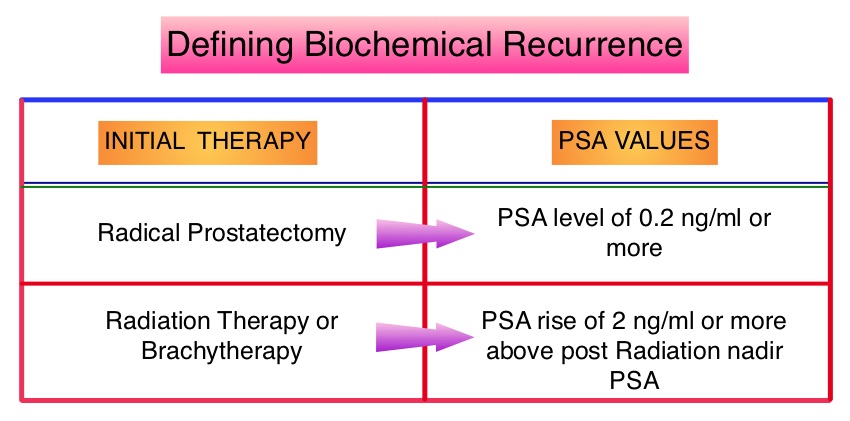 The American Urological Association suggested that a PSA of 0.2 ng/mL or higher defines PSA failure or relapse, after Radical Prostatectomy. A PSA rise of 2 ng/ml or more above post Radiation Therapy nadir, is considered PSA failure or relapse. Approximately 35% of the patients with prostate cancer will experience PSA only relapse within 10 years of their primary treatment and a third of these patients will develop documented metastatic disease within 8 years following PSA only relapse. Prostate cancer patients who had thought that they were cured, consequently can experience considerable mental anguish and anxiety, based on these laboratory findings. Androgen Deprivation Therapy (ADT) is often initiated following PSA only relapse with the intent of delaying disease progression although the role of ADT and optimal timing to start ADT (Immediate vs deferred ADT) in this patient population is unknown. Further, ADT can be associated with side effects such as fatigue, loss of muscle mass, impotence, anemia, osteoporosis, etc., which in turn can have a significant negative impact on an individual’s quality of life. In order to determine the significance of benefit if any, with starting ADT while patients are asymptomatic, the authors analyzed data on more than 14,000 patients included in a prospective registry called CaPSURE (Cancer of the Prostate Strategic Urologic Research Endeavor) and of them studied 2,022 men, who had experienced a PSA only relapse following curative surgery or radiation. These patients had clinical stage T3a,N0M0 or lower stage prostate cancer and experienced PSA only relapse (defined as PSA of 0.2 ng/mL or higher after Radical Prostatectomy or three rising PSA values one month apart following radiation treatment. Patients with symptoms, documented metastatic disease by CT scan or bone scan and ADT in the previous 12 months were excluded. Patients in the” Immediate treatment group” initiated ADT within 3 months of PSA relapse and those in the “Deferred treatment group” initiated ADT, 2 or more years after PSA relapse or when they presented with metastasis, symptoms or had a short PSA doubling time. The median age was 69 years, 34% had a Gleason score >7 and 32% received radiotherapy as primary treatment. The median time from primary treatment to PSA relapse was 27 months. Patients were followed for a median of 52.3 months after PSA relapse. The Five-year survival rate for Patients in the” Immediate treatment group” was 85.1% and for those in the “Deferred treatment group” was 87.2% with no significant difference in the all cause mortality. The 10 year survival was identical in both groups at 71.6%. The authors concluded that there is little or no survival benefit for Immediate ADT initiation compared with Deferred ADT initiation (at clinical progression or at least two years after PSA relapse) among prostate cancer patients with PSA only relapse. Therefore delaying ADT for at least 2 years after PSA relapse, following curative therapy for prostate cancer does not worsen overall survival. The findings from this large observational study will need further validation and a randomized phase III trial is underway to confirm these findings. Garcia-Albeniz X, Chan JM, Paciorek AT, et al. J Clin Oncol 32:5s, 2014 (suppl; abstr 5003)
The American Urological Association suggested that a PSA of 0.2 ng/mL or higher defines PSA failure or relapse, after Radical Prostatectomy. A PSA rise of 2 ng/ml or more above post Radiation Therapy nadir, is considered PSA failure or relapse. Approximately 35% of the patients with prostate cancer will experience PSA only relapse within 10 years of their primary treatment and a third of these patients will develop documented metastatic disease within 8 years following PSA only relapse. Prostate cancer patients who had thought that they were cured, consequently can experience considerable mental anguish and anxiety, based on these laboratory findings. Androgen Deprivation Therapy (ADT) is often initiated following PSA only relapse with the intent of delaying disease progression although the role of ADT and optimal timing to start ADT (Immediate vs deferred ADT) in this patient population is unknown. Further, ADT can be associated with side effects such as fatigue, loss of muscle mass, impotence, anemia, osteoporosis, etc., which in turn can have a significant negative impact on an individual’s quality of life. In order to determine the significance of benefit if any, with starting ADT while patients are asymptomatic, the authors analyzed data on more than 14,000 patients included in a prospective registry called CaPSURE (Cancer of the Prostate Strategic Urologic Research Endeavor) and of them studied 2,022 men, who had experienced a PSA only relapse following curative surgery or radiation. These patients had clinical stage T3a,N0M0 or lower stage prostate cancer and experienced PSA only relapse (defined as PSA of 0.2 ng/mL or higher after Radical Prostatectomy or three rising PSA values one month apart following radiation treatment. Patients with symptoms, documented metastatic disease by CT scan or bone scan and ADT in the previous 12 months were excluded. Patients in the” Immediate treatment group” initiated ADT within 3 months of PSA relapse and those in the “Deferred treatment group” initiated ADT, 2 or more years after PSA relapse or when they presented with metastasis, symptoms or had a short PSA doubling time. The median age was 69 years, 34% had a Gleason score >7 and 32% received radiotherapy as primary treatment. The median time from primary treatment to PSA relapse was 27 months. Patients were followed for a median of 52.3 months after PSA relapse. The Five-year survival rate for Patients in the” Immediate treatment group” was 85.1% and for those in the “Deferred treatment group” was 87.2% with no significant difference in the all cause mortality. The 10 year survival was identical in both groups at 71.6%. The authors concluded that there is little or no survival benefit for Immediate ADT initiation compared with Deferred ADT initiation (at clinical progression or at least two years after PSA relapse) among prostate cancer patients with PSA only relapse. Therefore delaying ADT for at least 2 years after PSA relapse, following curative therapy for prostate cancer does not worsen overall survival. The findings from this large observational study will need further validation and a randomized phase III trial is underway to confirm these findings. Garcia-Albeniz X, Chan JM, Paciorek AT, et al. J Clin Oncol 32:5s, 2014 (suppl; abstr 5003)
Author: RR
Final results of a randomized phase 2 study showing the clinical benefit of quizartinib (AC220) in patients with FLT3-ITD positive relapsed or refractory acute myeloid leukemia
SUMMARY: Acute Myeloid Leukemia (AML) is generally a disease of the elderly and the average age of a patient at the time of diagnosis is about 66 years. According to the American Cancer Society, approximately 18,860 new cases of AML will be diagnosed in 2014 and 10,460 patients will die of the disease. AML can be considered as a group of heterogeneous diseases with different clinical behavior and outcomes. Even though cytotoxic chemotherapy may lead to long term remission and cure in a minority of patients with favorable cytogenetics, patients with high risk features such as unfavorable cytogenetics, molecular abnormalities, prior myelodysplasia and advanced age, have poor outcomes with conventional chemotherapy. 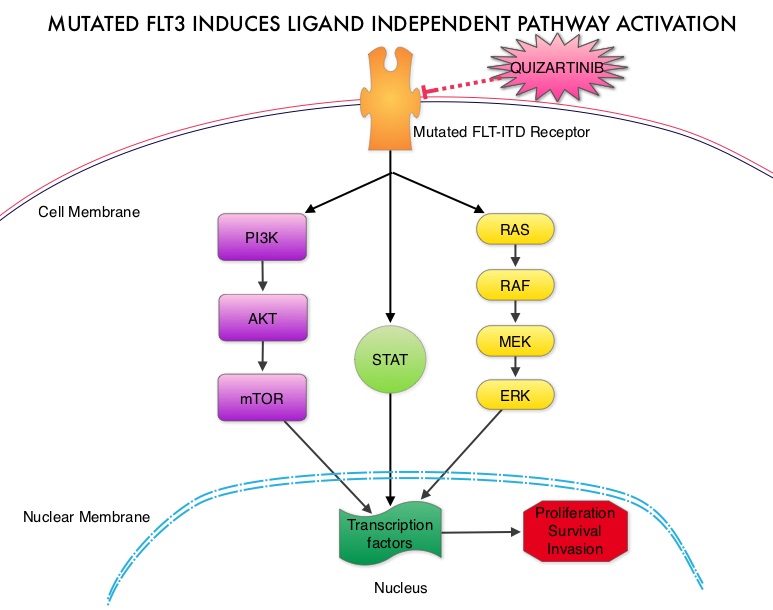 The fms-like tyrosine kinase 3 (FLT3) is a receptor tyrosine kinase in the PDGF family of growth factor receptors located on the cell surface (transmembrane) and plays an important role in both normal and malignant hematopoiesis by activating key signaling pathways. Activating mutations in the FLT3 receptor is the most common genetic abnormality in AML and is detected in approximately 30% of the patients. The most common FLT3 mutation is the FLT3-ITD (Internal Tandem Duplication) mutation caused by a tandem duplication within the coding region of the gene. The presence of FLT3-ITD mutations can negate the benefit of any other favorable molecular and cytogenetic features. Patients with FLT3-ITD mutations have poor outcomes with shorter remission duration and significantly decreased leukemia free and overall survival. These mutations are detected using Polymerase Chain Reaction (PCR) based molecular diagnostic DNA testing. Several therapeutic agents are being developed to target FLT3 mutations. Quizartinib (AC220) is an oral tyrosine kinase inhibitor, which has demonstrated activity in patients with both wild type FLT3 as well as those with FLT3-ITD mutations. In this randomized, open label phase II study, the authors evaluated the efficacy and safety of two different, lower dosages of Quizartinib, in patients 18 years of age or older, with FLT3-ITD positive, relapsed or refractory AML. Seventy six patients (N=76) were randomized to receive either Quizartinib 30 mg/day (Group A) or Quizartinib 60 mg/day (Group B), given orally and continuously, during a 28 day treatment cycle. Treatment was continued until relapse, intolerance or Hematopoietic Stem Cell Transplantation (HSCT). Both groups were well balanced except for age over 60 years (42% Group A, 26% Group B) and the percentage with secondary AML (8% Group A, 18% Group B). The composite Complete Remission (CRc) rate included Complete Remission (CR), Complete Remission with incomplete platelet recovery (CRp), and Complete Remission with incomplete hematologic recovery (CRi). The CRc rate in both groups A and B was 47% and the Overall Response Rate (CRc + Partial Response (PR)) was 61% in Group A and 71% in Group B. Further, 32% of patiens in Group A and 42% in Group B were able to undergo HSCT, after achieving CRc or PR. The most common treatment related adverse events were diarrhea (18%), febrile neutropenia (16%), and QT prolongation (15%). The QT prolongation rate was significantly less with lower doses of Quizartinib, as was used in this study, compared to what was noted with higher doses of Quizartinib utilized in other trials. The authors concluded that Quizartinib is highly effective in relapsed and refractory AML patients with FLT3-ITD mutations, with an acceptable safety profile. Schiller GJ, Tallman MS, Goldberg SL, et al. J Clin Oncol 32:5s, 2014 (suppl; abstr 7100)
The fms-like tyrosine kinase 3 (FLT3) is a receptor tyrosine kinase in the PDGF family of growth factor receptors located on the cell surface (transmembrane) and plays an important role in both normal and malignant hematopoiesis by activating key signaling pathways. Activating mutations in the FLT3 receptor is the most common genetic abnormality in AML and is detected in approximately 30% of the patients. The most common FLT3 mutation is the FLT3-ITD (Internal Tandem Duplication) mutation caused by a tandem duplication within the coding region of the gene. The presence of FLT3-ITD mutations can negate the benefit of any other favorable molecular and cytogenetic features. Patients with FLT3-ITD mutations have poor outcomes with shorter remission duration and significantly decreased leukemia free and overall survival. These mutations are detected using Polymerase Chain Reaction (PCR) based molecular diagnostic DNA testing. Several therapeutic agents are being developed to target FLT3 mutations. Quizartinib (AC220) is an oral tyrosine kinase inhibitor, which has demonstrated activity in patients with both wild type FLT3 as well as those with FLT3-ITD mutations. In this randomized, open label phase II study, the authors evaluated the efficacy and safety of two different, lower dosages of Quizartinib, in patients 18 years of age or older, with FLT3-ITD positive, relapsed or refractory AML. Seventy six patients (N=76) were randomized to receive either Quizartinib 30 mg/day (Group A) or Quizartinib 60 mg/day (Group B), given orally and continuously, during a 28 day treatment cycle. Treatment was continued until relapse, intolerance or Hematopoietic Stem Cell Transplantation (HSCT). Both groups were well balanced except for age over 60 years (42% Group A, 26% Group B) and the percentage with secondary AML (8% Group A, 18% Group B). The composite Complete Remission (CRc) rate included Complete Remission (CR), Complete Remission with incomplete platelet recovery (CRp), and Complete Remission with incomplete hematologic recovery (CRi). The CRc rate in both groups A and B was 47% and the Overall Response Rate (CRc + Partial Response (PR)) was 61% in Group A and 71% in Group B. Further, 32% of patiens in Group A and 42% in Group B were able to undergo HSCT, after achieving CRc or PR. The most common treatment related adverse events were diarrhea (18%), febrile neutropenia (16%), and QT prolongation (15%). The QT prolongation rate was significantly less with lower doses of Quizartinib, as was used in this study, compared to what was noted with higher doses of Quizartinib utilized in other trials. The authors concluded that Quizartinib is highly effective in relapsed and refractory AML patients with FLT3-ITD mutations, with an acceptable safety profile. Schiller GJ, Tallman MS, Goldberg SL, et al. J Clin Oncol 32:5s, 2014 (suppl; abstr 7100)
Belinostat, a novel pan-histone deacetylase inhibitor (HDACi), in relapsed or refractory peripheral T-cell lymphoma (R/R PTCL) Results from the BELIEF trial
SUMMARY: Non-Hodgkin lymphoma (NHL) is one of the most common cancers in the United States and the American Cancer Society estimates that in 2014, about 70,800 people will be diagnosed with NHL in the US and close to 19,000 people will die of the disease. T cell Lymphomas are a heterogenous group of lymphoid malignancies representing less than 15% of all Non-Hodgkin Lymphomas.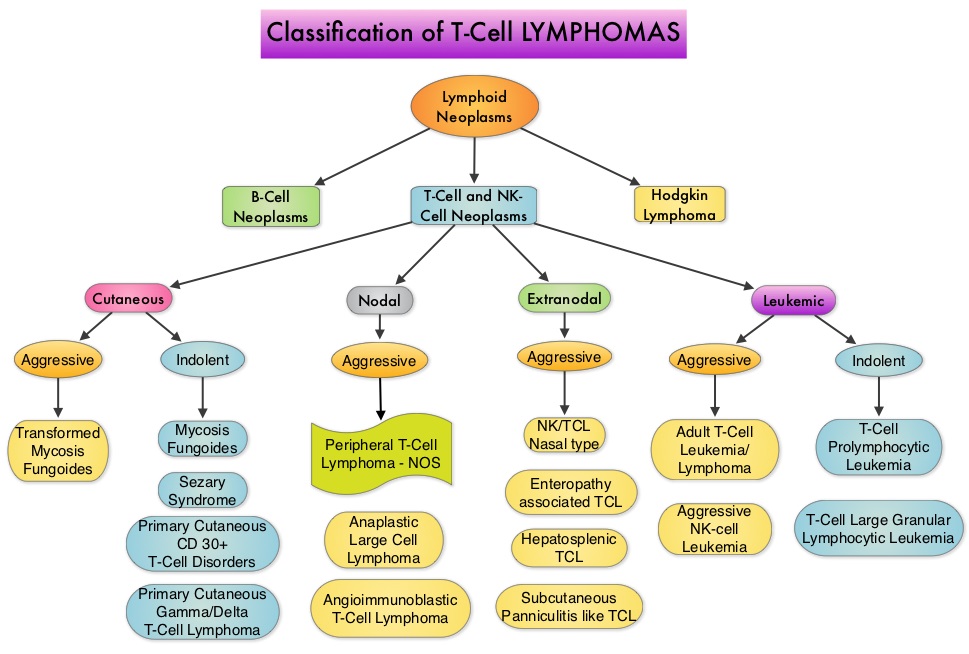
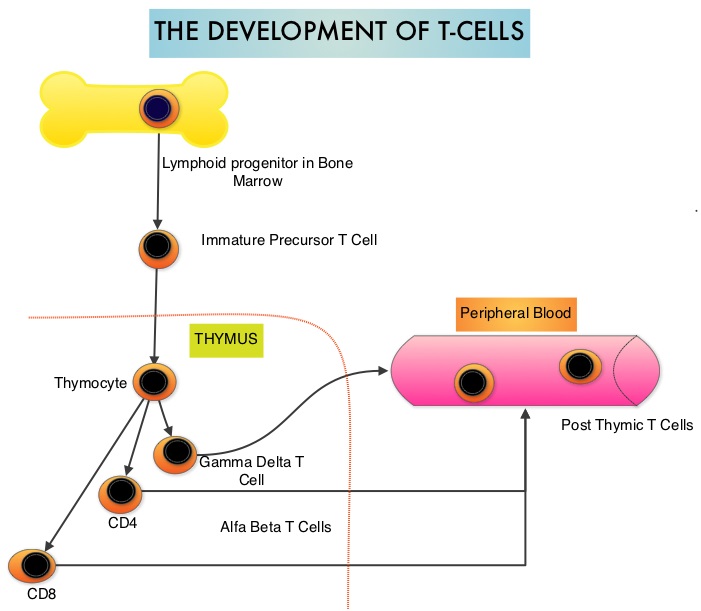 Peripheral T-cell lymphoma – NOS (PTCL-Not Otherwise Specified) is the most common of the aggressive T-cell lymphoma subtypes and accounts for 26% of all non-cutaneous PTCL’s. These malignancies are derived from mature post thymic T-cells and NK cells. These tumors are uncommon, tend to be aggressive and majority of the patients with T-cell lymphoma present with advanced stage disease and respond poorly to treatment. Relapse rates tend to be high and few patients achieve durable remission with treatment. For these reasons, prognosis remains poor. Agents from two pharmacological classes are presently available for the treatment of PTCL. The FDA granted accelerated approval to FOLOTYN® (Pralatrexate), an antifolate, in 2009, for use in patients with relapsed or refractory PTCL and to ISTODAX® (Romidepsin), a histone deacetylase (HDAC) inhibitor in 2011, for the treatment of PTCL patients, who had received at least one prior therapy.
Peripheral T-cell lymphoma – NOS (PTCL-Not Otherwise Specified) is the most common of the aggressive T-cell lymphoma subtypes and accounts for 26% of all non-cutaneous PTCL’s. These malignancies are derived from mature post thymic T-cells and NK cells. These tumors are uncommon, tend to be aggressive and majority of the patients with T-cell lymphoma present with advanced stage disease and respond poorly to treatment. Relapse rates tend to be high and few patients achieve durable remission with treatment. For these reasons, prognosis remains poor. Agents from two pharmacological classes are presently available for the treatment of PTCL. The FDA granted accelerated approval to FOLOTYN® (Pralatrexate), an antifolate, in 2009, for use in patients with relapsed or refractory PTCL and to ISTODAX® (Romidepsin), a histone deacetylase (HDAC) inhibitor in 2011, for the treatment of PTCL patients, who had received at least one prior therapy.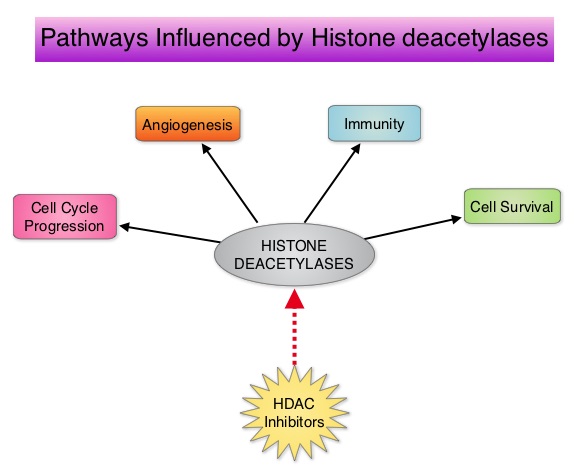 HDACs are a family of enzymes that play an important role in the regulation of gene expression. To briefly summarize the structure of a chromosome, individual loops of coiled double-helix DNA wrap around a histone protein to form a nucleosome. Nucleosomes are then coiled together to form chromatin fibers, which looks like beads on a string. The chromatin fibers are coiled even more tightly to form chromosomes. HDAC enzymes catalyze the removal of acetyl groups and regulate the level of acetylation of the histones and non-histone proteins and transcription of several genes. Hypoacetylation of histones has been associated with a condensed chromatin structure that results in the repression of gene transcription, whereas acetylated histones are associated with a more open chromatin structure and activation of gene transcription. HDACs are grouped into four major classes and regulate cell-cycle progression, cell survival, angiogenesis and immunity. BELEODAQ® (Belinostat) is a novel pan-histone deacetylase inhibitor and inhibits all 3 classes of the zinc-dependent HDAC enzymes.
HDACs are a family of enzymes that play an important role in the regulation of gene expression. To briefly summarize the structure of a chromosome, individual loops of coiled double-helix DNA wrap around a histone protein to form a nucleosome. Nucleosomes are then coiled together to form chromatin fibers, which looks like beads on a string. The chromatin fibers are coiled even more tightly to form chromosomes. HDAC enzymes catalyze the removal of acetyl groups and regulate the level of acetylation of the histones and non-histone proteins and transcription of several genes. Hypoacetylation of histones has been associated with a condensed chromatin structure that results in the repression of gene transcription, whereas acetylated histones are associated with a more open chromatin structure and activation of gene transcription. HDACs are grouped into four major classes and regulate cell-cycle progression, cell survival, angiogenesis and immunity. BELEODAQ® (Belinostat) is a novel pan-histone deacetylase inhibitor and inhibits all 3 classes of the zinc-dependent HDAC enzymes.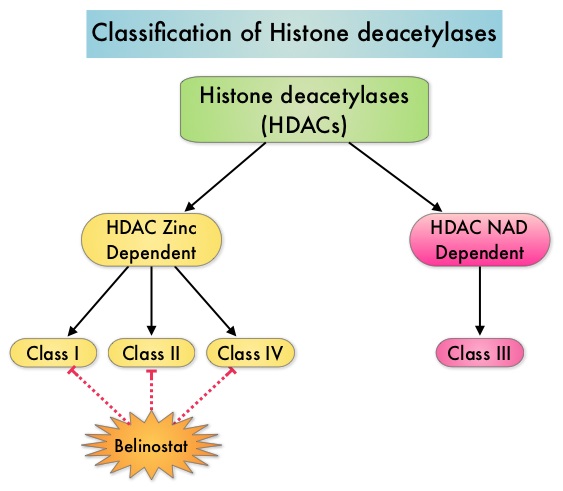 The approval of BELEODAQ® was based on the results of a multi-center, single-arm, phase II trial, in which 129 patients with relapsed or refractory PTCL, who had received a median of 2 prior therapies, were enrolled and evaluated. BELEODAQ® was administered as a 30 minute IV infusion at 1000 mg/m2 on days 1–5 of a 3 week cycle until progression or unacceptable toxicity. The median age was 63 years. The primary endpoint was Overall Response Rate (ORR). The ORR was 26% with 10% Complete Responses and 10% Partial responses and the median time to response was 5.6 weeks and the median duration of response was 8.3 months. The most common adverse events were nausea, vomiting, fatigue, fever and anemia. The most common grade 3/4 adverse events were thrombocytopenia (13%), neutropenia (13%), anemia (10%), dyspnea (6%), pneumonia (6%), and fatigue (5%). The authors concluded that BELEODAQ® demonstrated a significant overall response rate in relapsed /refractory PTCL patients, thus expanding the treatment options for these difficult to treat individuals. This was accomplished with a low incidence of myelosuppression and favorable safety profile. O'Connor OA, Masszi T, Savage KJ, et al. J Clin Oncol 31, 2013 (suppl; abstr 8507)
The approval of BELEODAQ® was based on the results of a multi-center, single-arm, phase II trial, in which 129 patients with relapsed or refractory PTCL, who had received a median of 2 prior therapies, were enrolled and evaluated. BELEODAQ® was administered as a 30 minute IV infusion at 1000 mg/m2 on days 1–5 of a 3 week cycle until progression or unacceptable toxicity. The median age was 63 years. The primary endpoint was Overall Response Rate (ORR). The ORR was 26% with 10% Complete Responses and 10% Partial responses and the median time to response was 5.6 weeks and the median duration of response was 8.3 months. The most common adverse events were nausea, vomiting, fatigue, fever and anemia. The most common grade 3/4 adverse events were thrombocytopenia (13%), neutropenia (13%), anemia (10%), dyspnea (6%), pneumonia (6%), and fatigue (5%). The authors concluded that BELEODAQ® demonstrated a significant overall response rate in relapsed /refractory PTCL patients, thus expanding the treatment options for these difficult to treat individuals. This was accomplished with a low incidence of myelosuppression and favorable safety profile. O'Connor OA, Masszi T, Savage KJ, et al. J Clin Oncol 31, 2013 (suppl; abstr 8507)
ZYDELIG® (Idelalisib)
The FDA on July 23, 2014 granted accelerated approval to ZYDELIG® for the treatment of patients with relapsed Follicular B-cell Non-Hodgkin Lymphoma (FL) or relapsed Small Lymphocytic Lymphoma (SLL) who have received at least two prior systemic therapies. ZYDELIG® tablets are a product of Gilead Sciences, Inc.
ZYDELIG® (Idelalisib)
The FDA on July 23, 2014 approved ZYDELIG® for the treatment of patients with relapsed Chronic Lymphocytic Leukemia (CLL), in combination with Rituximab (RITUXAN®), for whom RITUXAN® alone would be considered appropriate therapy due to other co-morbidities. ZYDELIG® tablets are a product of Gilead Sciences, Inc.
BELEODAQ® (Belinostat)
The FDA on July 3, 2014 granted accelerated approval to BELEODAQ® for the treatment of patients with relapsed or refractory Peripheral T-Cell Lymphoma (PTCL). BELEODAQ® is a product of Spectrum Pharmaceuticals, Inc.
Efficacy and safety of continued zoledronic acid every 4 weeks versus every 12 weeks in women with bone metastases from breast cancer Results of the OPTIMIZE-2 trial
SUMMARY: Bone is the most common site of metastatic disease, in patients with Breast Cancer. Bisphosphonates inhibit osteoclast-mediated bone resorption and both oral and IV bisphosphonates reduce the risk of developing Skeletal Related Events (SRE’s) and delay the time to SRE’s in patients with Breast Cancer with bone metastases. Bisphosphonates can also reduce bone pain and may improve Quality of life. Of the four bisphosphonates proven to be effective in patients with Breast Cancer with bone metastases, only intravenous Pamidronate (AREDIA®) and Zoledronic acid (ZOMETA®) have been approved in the USA, whereas intravenous and oral Ibandronate and oral Clodronate have been approved in Europe. Both AREDIA® and ZOMETA® are administered every 3 to 4 weeks during the first year, following diagnoses of bone metastases. However, the optimal treatment schedule following this initial phase of treatment has remained unclear. Further, renal toxicity, long bone fractures and OsteoNecrosis of the Jaw (ONJ) have been identified as potential problems with bisphosphonate use. OPTIMIZE-2 is a prospective, randomized, double-blind, multicenter trial, in which the authors evaluated the outcomes of a less intense schedule of ZOMETA® administered every 12 weeks, following one year of the standard initial phase of treatment with bisphosphonates. This study included 403 women with bone metastases from Breast Cancer, who had received 9 or more doses of either intravenous ZOMETA® or AREDIA®, during the first 10-15 months of therapy. The median age was 59 years and patients were randomized (1:1) to receive either ZOMETA® 4 mg IV every 4 weeks (N=200) or every 12 weeks (N=203), for one year. The primary endpoint was Skeletal Related Event (SRE) rate, defined as the proportion of patients with one or more SRE’s (pathologic fractures, spinal cord compression, need for radiotherapy or surgical stabilization of the bone). The primary analysis was non-inferiority, for the difference in SRE rates between the treatment groups. Secondary endpoints included time to first SRE, Skeletal Morbidity Rate (SMR), bone pain score, change in bone turnover markers, and safety. After a median follow up of 11.9 months, the SRE rate was 22% and 23.2% in the ZOMETA® every 4 weeks group and ZOMETA® every 12 weeks group respectively (P=0.724), suggesting that ZOMETA® given every 12 weeks was non-inferior to the q 4 week regimen. The secondary endpoints were comparable as well. More patients had renal toxicities in the ZOMETA® q 4 week group vs q 12 week group (9.6% vs 7.9%, respectively) and two cases (1.0%) of OsteoNecrosis of the Jaw (ONJ) were reported in the ZOMETA® q 4 week group. The authors concluded that the efficacy of continuing ZOMETA® for an additional year at the q 12 week schedule was non-inferior to ZOMETA® given q 4 weeks, among patients who had initially received IV bisphosphonates monthly, for one year or longer. Further the less frequent dosing of ZOMETA® compared with the standard monthly dosing, may be more convenient for the patients and result in less toxicities. Hortobagyi GN, Lipton A, Chew HK, et al. J Clin Oncol 32:5s, 2014 (suppl; abstr LBA9500)
OPTIMIZE-2 is a prospective, randomized, double-blind, multicenter trial, in which the authors evaluated the outcomes of a less intense schedule of ZOMETA® administered every 12 weeks, following one year of the standard initial phase of treatment with bisphosphonates. This study included 403 women with bone metastases from Breast Cancer, who had received 9 or more doses of either intravenous ZOMETA® or AREDIA®, during the first 10-15 months of therapy. The median age was 59 years and patients were randomized (1:1) to receive either ZOMETA® 4 mg IV every 4 weeks (N=200) or every 12 weeks (N=203), for one year. The primary endpoint was Skeletal Related Event (SRE) rate, defined as the proportion of patients with one or more SRE’s (pathologic fractures, spinal cord compression, need for radiotherapy or surgical stabilization of the bone). The primary analysis was non-inferiority, for the difference in SRE rates between the treatment groups. Secondary endpoints included time to first SRE, Skeletal Morbidity Rate (SMR), bone pain score, change in bone turnover markers, and safety. After a median follow up of 11.9 months, the SRE rate was 22% and 23.2% in the ZOMETA® every 4 weeks group and ZOMETA® every 12 weeks group respectively (P=0.724), suggesting that ZOMETA® given every 12 weeks was non-inferior to the q 4 week regimen. The secondary endpoints were comparable as well. More patients had renal toxicities in the ZOMETA® q 4 week group vs q 12 week group (9.6% vs 7.9%, respectively) and two cases (1.0%) of OsteoNecrosis of the Jaw (ONJ) were reported in the ZOMETA® q 4 week group. The authors concluded that the efficacy of continuing ZOMETA® for an additional year at the q 12 week schedule was non-inferior to ZOMETA® given q 4 weeks, among patients who had initially received IV bisphosphonates monthly, for one year or longer. Further the less frequent dosing of ZOMETA® compared with the standard monthly dosing, may be more convenient for the patients and result in less toxicities. Hortobagyi GN, Lipton A, Chew HK, et al. J Clin Oncol 32:5s, 2014 (suppl; abstr LBA9500)
Increased Risk of Pancreatic Adenocarcinoma After Acute Pancreatitis
SUMMARY: The American Cancer Society estimates that in 2014, over 46,000 people will be diagnosed with Pancreatic Cancer in the United States and close to 40,000 people will die of the disease. Some important risk factors for Pancreatic Cancer include increasing age, obesity, smoking history, genetic predisposition, exposure to certain dyes and chemicals, heavy alcohol use and pancreatitis. The best chance for long term survival is complete surgical resection, although this may not be feasible in a majority of the patients, as they present with advanced disease, at the time of diagnosis. Based on the National Cancer Data Base, the 5 year observed survival rate for patients diagnosed with exocrine cancer of the pancreas is 14% for those with Stage IA disease and 1% for those with Stage IV disease. Early diagnosis may therefore play an important role in treatment outcomes, in patients with Pancreatic Cancer. Pancreatic Cancer can cause acute pancreatitis by obstructing the pancreatic duct and patients diagnosed with Pancreatic Cancer often present initially with acute pancreatitis. With this background information, the authors performed a retrospective study of patients with acute pancreatitis who sought their medical care at the Veterans Health Administration from 1998 through 2007. 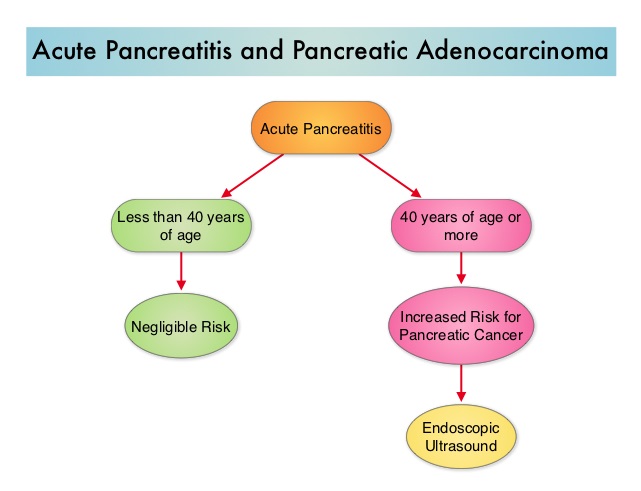 Patients with pre-existing Pancreatic Adenocarcinoma or those with recurrent acute pancreatitis were excluded from this analysis. A diagnosis of acute pancreatitis was made in 5720 patients and 710 patients were diagnosed with Pancreatic Cancer from 2000 through 2007. They noted that of those who were diagnosed with Pancreatic Adenocarcinoma, 76 patients (10.7%) had acute pancreatitis within 2 years of Pancreatic Cancer diagnosis. This risk for Pancreatic Cancer was greatest during the ï¬rst year following diagnosis of acute pancreatitis and this risk decreased rapidly thereafter. Patients less than 40 years of age had negligible risk whereas those 70 years of age or older had the highest risk. The authors concluded that a signiï¬cant number of patients with Pancreatic Adenocarcinoma (12.1%) initially present with acute pancreatitis and the diagnosis of cancer is often delayed by up to 2 years. Acute pancreatitis should be considered as an index event which in turn may identify a population of patients at high risk to develop Pancreatic Adenocarcinoma. They recommend that Endoscopic UltraSound (EUS) should be performed in these high risk patients, following diagnosis of acute pancreatitis, before discharge from the hospital, as this test is highly sensitive in picking up small tumors in the pancreas that are amenable to surgical resection. This is in comparison with contrast enhanced CT scans and pancreatic protocol CT scans that are not as sensitive in identifying tumors less than 2 cm in size. This interesting analysis could potentially open the doors for pancreatic cancer screening in high risk patients. Munigala S, Kanwal F, Xian H, et al. Clinical Gastroenterology and Hepatology 2014;12:1143-1150
Patients with pre-existing Pancreatic Adenocarcinoma or those with recurrent acute pancreatitis were excluded from this analysis. A diagnosis of acute pancreatitis was made in 5720 patients and 710 patients were diagnosed with Pancreatic Cancer from 2000 through 2007. They noted that of those who were diagnosed with Pancreatic Adenocarcinoma, 76 patients (10.7%) had acute pancreatitis within 2 years of Pancreatic Cancer diagnosis. This risk for Pancreatic Cancer was greatest during the ï¬rst year following diagnosis of acute pancreatitis and this risk decreased rapidly thereafter. Patients less than 40 years of age had negligible risk whereas those 70 years of age or older had the highest risk. The authors concluded that a signiï¬cant number of patients with Pancreatic Adenocarcinoma (12.1%) initially present with acute pancreatitis and the diagnosis of cancer is often delayed by up to 2 years. Acute pancreatitis should be considered as an index event which in turn may identify a population of patients at high risk to develop Pancreatic Adenocarcinoma. They recommend that Endoscopic UltraSound (EUS) should be performed in these high risk patients, following diagnosis of acute pancreatitis, before discharge from the hospital, as this test is highly sensitive in picking up small tumors in the pancreas that are amenable to surgical resection. This is in comparison with contrast enhanced CT scans and pancreatic protocol CT scans that are not as sensitive in identifying tumors less than 2 cm in size. This interesting analysis could potentially open the doors for pancreatic cancer screening in high risk patients. Munigala S, Kanwal F, Xian H, et al. Clinical Gastroenterology and Hepatology 2014;12:1143-1150
Trastuzumab emtansine versus treatment of physician's choice for pretreated HER2-positive advanced breast cancer (TH3RESA) a randomised, open-label, phase 3 trial
SUMMARY: Breast cancer is the most common cancer among women in the US and about 1 in 8 women (12%) will develop invasive breast cancer during their lifetime. Approximately, 233,000 new cases of invasive breast cancer will be diagnosed in 2014 and 40,000 women will die of the disease. The HER or erbB family of receptors consist of HER1, HER2, HER3 and HER4. Approximately 15%-20% of invasive breast cancers overexpress HER2/neu oncogene, which is a negative predictor of outcomes without systemic therapy. HERCEPTIN® (Trastuzumab) is a humanized monoclonal antibody targeting HER2. It binds to the extracellular domain of the receptor and blocks the downstream cell signaling pathways (PI3K-AKT pathway) and induces Antibody Dependent Cellular Cytotoxicity (ADCC). HERCEPTIN® in combination with chemotherapy has been proven to significantly improve Progression Free Survival and Overall Survival in patients with advanced breast cancer. Despite this benefit, majority of these patients develop progressive disease within 18 months. The tumors in these patients continue to express HER2 although the lower sensitivity to HER2 targeted agents has been attributed to HER2 independent escape mechanisms. Treatment strategies for this patient population have included switching chemotherapy in subsequent lines of treatment and continuing HERCEPTIN®, combining another HER2 targeted agent, Lapatinib (TYKERB®) with Capecitabine (XELODA®) and dual HER2 inhibition with a combination of HERCEPTIN® and TYKERB®. KADCYLA® (Ado-Trastuzumab Emtansine, T-DM1) is an antibody-drug conjugate (ADC) comprised of the antibody HERCEPTIN® and the chemotherapy agent Emtansine, linked together. Upon binding to the HER2 receptor, it not only inhibits the HER2 signaling pathways but also delivers a chemotherapy agent Emtansine, a microtubule inhibitor, directly inside the tumor cells. This agent is internalized by lysosomes and destroys the HER2-positive tumor cells upon intracellular release.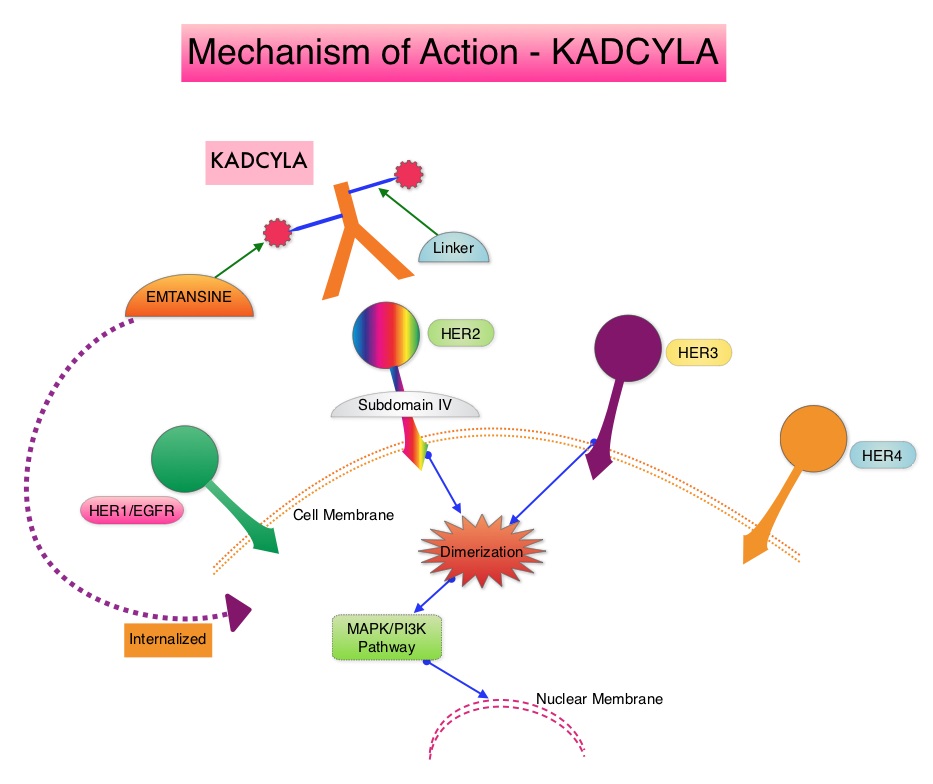 In the EMILIA trial, KADCYLA® was associated with significant increase in Overall Survival when compared with TYKERB® and XELODA® in HER2-positive metastatic breast cancer patients, who had previously received HERCEPTIN® and a taxane. This study however excluded patients who had previously received TYKERB®. TH3RESA is an open label randomized phase III trial in which KADCYLA® was compared with treatment of physician’s choice, in patients with unresectable locally advanced, recurrent or metastatic breast cancer. Eligible patients had a left ventricular ejection fraction of 50% or more, ECOG performance status of 0-2 and had HER2-positive advanced breast cancer who had received two or more HER2-directed regimens in the advanced setting and had progressed on both HERCEPTIN® and TYKERB® containing regimens in metastatic setting and also had disease progression on a taxane, in any setting. Patients were randomized in a 2:1 ratio to receive either KADCYLA® 3•6 mg/kg intravenously every 21 days (N=404) or treatment of physician’s choice (N=198). Treatment was continued until disease progression or unmanageable toxicity. The Co-primary endpoints were Progression Free Survival (PFS) and Overall Survival. Secondary endpoints included Response Rates, duration of response, safety and quality of life. After a median follow up of 7•2 months in the KADCYLA® group and 6•5 months in the physician's treatment choice group, there was a significant improvement in Progression Free Survival with KADCYLA® compared with physician's treatment choice (6•2 months vs 3•3 months, HR= 0•528, P<0•0001). The interim Overall Survival analysis showed a trend favoring KADCYLA® (HR=0•552, P=0•0034). Patients in the KADCYLA® group had a lower incidence of grade 3 toxicities compared to the patients in the physician’s treatment choice group (32% vs 43%). Grade 3 thrombocytopenia however was more common in the KADCYLA® group compared to the physician’s choice group (5% vs 2%) and this has been attributed to the inhibition of megakaryocyte differentiation by KADCYLA®. The authors concluded that KADCYLA® should be considered the treatment of choice, for patients with HER2-positive advanced breast cancer, who have previously received HERCEPTIN® and TYKERB®. It remains to be seen however, if KADCYLA® is effective in patients who had progressed on Pertuzumab (PERJETA®) based therapies. Krop IE, Kim SB, González-Martín A, et al. Lancet Oncol. 2014;15:689-699
In the EMILIA trial, KADCYLA® was associated with significant increase in Overall Survival when compared with TYKERB® and XELODA® in HER2-positive metastatic breast cancer patients, who had previously received HERCEPTIN® and a taxane. This study however excluded patients who had previously received TYKERB®. TH3RESA is an open label randomized phase III trial in which KADCYLA® was compared with treatment of physician’s choice, in patients with unresectable locally advanced, recurrent or metastatic breast cancer. Eligible patients had a left ventricular ejection fraction of 50% or more, ECOG performance status of 0-2 and had HER2-positive advanced breast cancer who had received two or more HER2-directed regimens in the advanced setting and had progressed on both HERCEPTIN® and TYKERB® containing regimens in metastatic setting and also had disease progression on a taxane, in any setting. Patients were randomized in a 2:1 ratio to receive either KADCYLA® 3•6 mg/kg intravenously every 21 days (N=404) or treatment of physician’s choice (N=198). Treatment was continued until disease progression or unmanageable toxicity. The Co-primary endpoints were Progression Free Survival (PFS) and Overall Survival. Secondary endpoints included Response Rates, duration of response, safety and quality of life. After a median follow up of 7•2 months in the KADCYLA® group and 6•5 months in the physician's treatment choice group, there was a significant improvement in Progression Free Survival with KADCYLA® compared with physician's treatment choice (6•2 months vs 3•3 months, HR= 0•528, P<0•0001). The interim Overall Survival analysis showed a trend favoring KADCYLA® (HR=0•552, P=0•0034). Patients in the KADCYLA® group had a lower incidence of grade 3 toxicities compared to the patients in the physician’s treatment choice group (32% vs 43%). Grade 3 thrombocytopenia however was more common in the KADCYLA® group compared to the physician’s choice group (5% vs 2%) and this has been attributed to the inhibition of megakaryocyte differentiation by KADCYLA®. The authors concluded that KADCYLA® should be considered the treatment of choice, for patients with HER2-positive advanced breast cancer, who have previously received HERCEPTIN® and TYKERB®. It remains to be seen however, if KADCYLA® is effective in patients who had progressed on Pertuzumab (PERJETA®) based therapies. Krop IE, Kim SB, González-Martín A, et al. Lancet Oncol. 2014;15:689-699
Efficacy and safety of the anti-PD-1 monoclonal antibody MK-3475 in 411 patients (pts) with melanoma (MEL)
SUMMARY: It is estimated that in the US, approximately 76,000 new cases of melanoma will be diagnosed and close to 8000 individuals will die of the disease in 2014. The incidence of melanoma has been on the rise for the past three decades. Unlike other malignancies, the role of chemotherapy for the treatment of melanoma has been limited. Treatment of advanced melanoma with immunotherapy using a cytokine, Interleukin-2 (IL-2) produced by T cells during an immune response, was first explored in the mid 1970’s. Durable responses were noted in a very small percentage of patients but this was associated with significant toxicities. This however opened the doors for the development of various immunotherapies, with a better understanding of the Immune checkpoints. Immune checkpoints are cell surface inhibitory proteins/receptors that harness the immune system and prevent uncontrolled immune reactions. Survival of cancer cells in the human body may be to a significant extent, related to their ability to escape immune surveillance, by inhibiting T lymphocyte activation. The T cells of the immune system play a very important role in modulating the immune system. Under normal circumstances, inhibition of an intense immune response, by switching off the T cells of the immune system, is an evolutionary mechanism and is accomplished by Immune checkpoints or Gate Keepers. With the recognition of Immune checkpoint proteins and their role in suppressing antitumor immunity, antibodies are being developed that target the membrane bound inhibitory Immune checkpoint proteins/receptors such as CTLA-4 (Cytotoxic T-Lymphocyte Antigen 4, also known as CD152), PD-1 (Programmed cell Death-1), etc. By doing so, one would expect to unleash the T cells, resulting in T cell proliferation, activation and a therapeutic response. The first immune checkpoint protein to be clinically targeted was CTLA-4. YERVOY® (Ipilimumab), an antibody that blocks Immune checkpoint protein/receptor CTLA- 4, has been shown to prolong overall survival in patients with previously treated, unresectable or metastatic melanoma.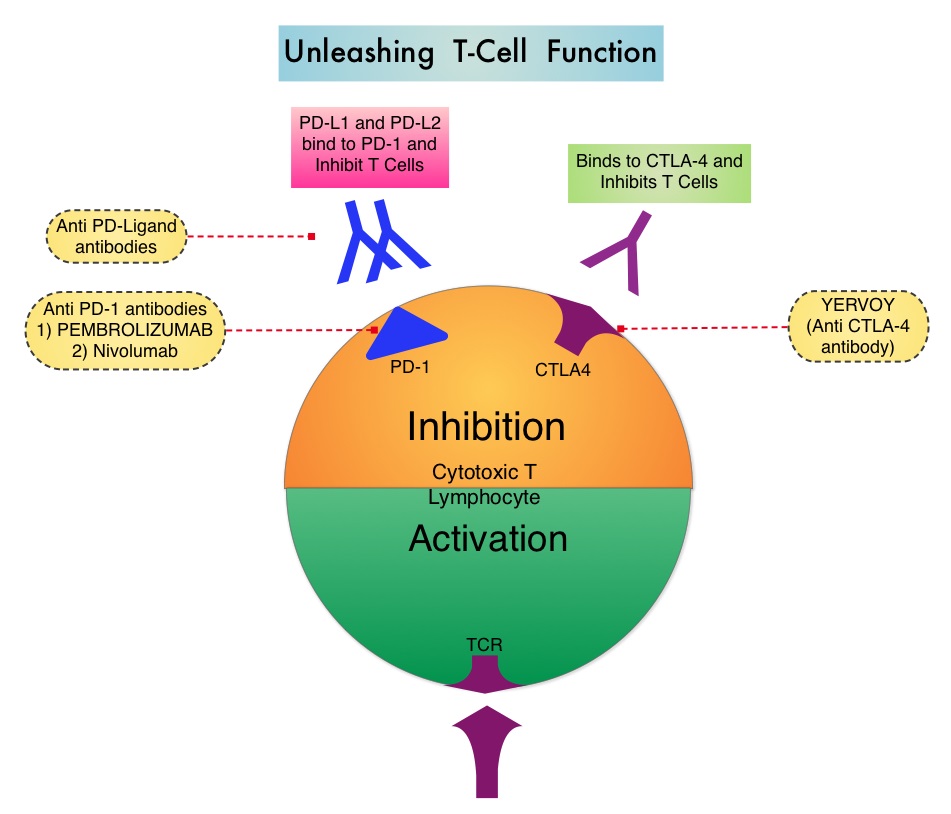 The Food and Drug Administration in May 2014, granted Pembrolizumab a Priority Review designation under its Accelerated Approval Program. Pembrolizumab was previously granted a Breakthrough Therapy designation for advanced melanoma. The authors in this largest phase I clinical trial ever done in patients with malignant melanoma, evaluated the efficacy and safety of Pembrolizumab (formerly known as MK-3475, Lambrolizumab), a humanized monoclonal IgG4 anti PD-1 antibody, in a pooled analysis of 411 patients with advanced melanoma. Of these patients, 221 patients had prior therapy with Ipilimumab (YERVOY® ) and 190 patients were YERVOY® naïve. In this study, three different dosing schedules for Pembrolizumab were utilized – 2 mg/kg every three weeks (N=162), 10 mg/kg every three weeks (N=192) and 10 mg/kg every two weeks (N=57). At the time of this analysis, all patients had at least 6 months of follow up and 75% of the patients had been followed up for at least 9 months. The Overall Response Rate was 40% in the YERVOY® naïve group and 28% in the YERVOY® treated group. Responses were durable and ongoing (88% ongoing) at the time of this analysis. The duration of responses ranged from 6 to 76 weeks, and the median response duration has not yet been reached. The median Progression Free Survival was 24 weeks in YERVOY® naïve group and 23 weeks in the YERVOY® treated group. The median Overall Survival has not been reached at the time of this analysis and the estimated 1 year Overall Survival rate for all patients was 71%. The activity with Pembrolizumab was demonstrated across all dose levels and patient subgroups, irrespective of prior YERVOY® therapy, performance status, LDH levels, BRAF mutation status, tumor stage, and number, as well as type of prior therapies. The most common adverse events of any grade were fatigue, pruritus and rash. Only 4% of the patients discontinued treatment due to a drug related toxicities and overall, 12% of patients experienced grade 3/4 adverse events. The authors concluded that the PD-1 targeting antibody, Pembrolizumab, produced durable responses in patients with advanced melanoma, regardless of prior therapy with YERVOY® and this benefit was accomplished with minimal toxicities. This efficacy data is comparable to another PD-1 targeted monoclonal antibody, Nivolumab. Because of the lack of cross resistance between anti PD-1 antibodies and YERVOY®, combining PD-1 targeted monoclonal antibody with a CTLA-4 targeted antibody such as YERVOY®, could potentially be synergistic, with better outcomes. Ribas A, Hodi FS, Kefford R, et al. J Clin Oncol 32:5s, 2014 (suppl; abstr LBA 9000)</s
The Food and Drug Administration in May 2014, granted Pembrolizumab a Priority Review designation under its Accelerated Approval Program. Pembrolizumab was previously granted a Breakthrough Therapy designation for advanced melanoma. The authors in this largest phase I clinical trial ever done in patients with malignant melanoma, evaluated the efficacy and safety of Pembrolizumab (formerly known as MK-3475, Lambrolizumab), a humanized monoclonal IgG4 anti PD-1 antibody, in a pooled analysis of 411 patients with advanced melanoma. Of these patients, 221 patients had prior therapy with Ipilimumab (YERVOY® ) and 190 patients were YERVOY® naïve. In this study, three different dosing schedules for Pembrolizumab were utilized – 2 mg/kg every three weeks (N=162), 10 mg/kg every three weeks (N=192) and 10 mg/kg every two weeks (N=57). At the time of this analysis, all patients had at least 6 months of follow up and 75% of the patients had been followed up for at least 9 months. The Overall Response Rate was 40% in the YERVOY® naïve group and 28% in the YERVOY® treated group. Responses were durable and ongoing (88% ongoing) at the time of this analysis. The duration of responses ranged from 6 to 76 weeks, and the median response duration has not yet been reached. The median Progression Free Survival was 24 weeks in YERVOY® naïve group and 23 weeks in the YERVOY® treated group. The median Overall Survival has not been reached at the time of this analysis and the estimated 1 year Overall Survival rate for all patients was 71%. The activity with Pembrolizumab was demonstrated across all dose levels and patient subgroups, irrespective of prior YERVOY® therapy, performance status, LDH levels, BRAF mutation status, tumor stage, and number, as well as type of prior therapies. The most common adverse events of any grade were fatigue, pruritus and rash. Only 4% of the patients discontinued treatment due to a drug related toxicities and overall, 12% of patients experienced grade 3/4 adverse events. The authors concluded that the PD-1 targeting antibody, Pembrolizumab, produced durable responses in patients with advanced melanoma, regardless of prior therapy with YERVOY® and this benefit was accomplished with minimal toxicities. This efficacy data is comparable to another PD-1 targeted monoclonal antibody, Nivolumab. Because of the lack of cross resistance between anti PD-1 antibodies and YERVOY®, combining PD-1 targeted monoclonal antibody with a CTLA-4 targeted antibody such as YERVOY®, could potentially be synergistic, with better outcomes. Ribas A, Hodi FS, Kefford R, et al. J Clin Oncol 32:5s, 2014 (suppl; abstr LBA 9000)</s
